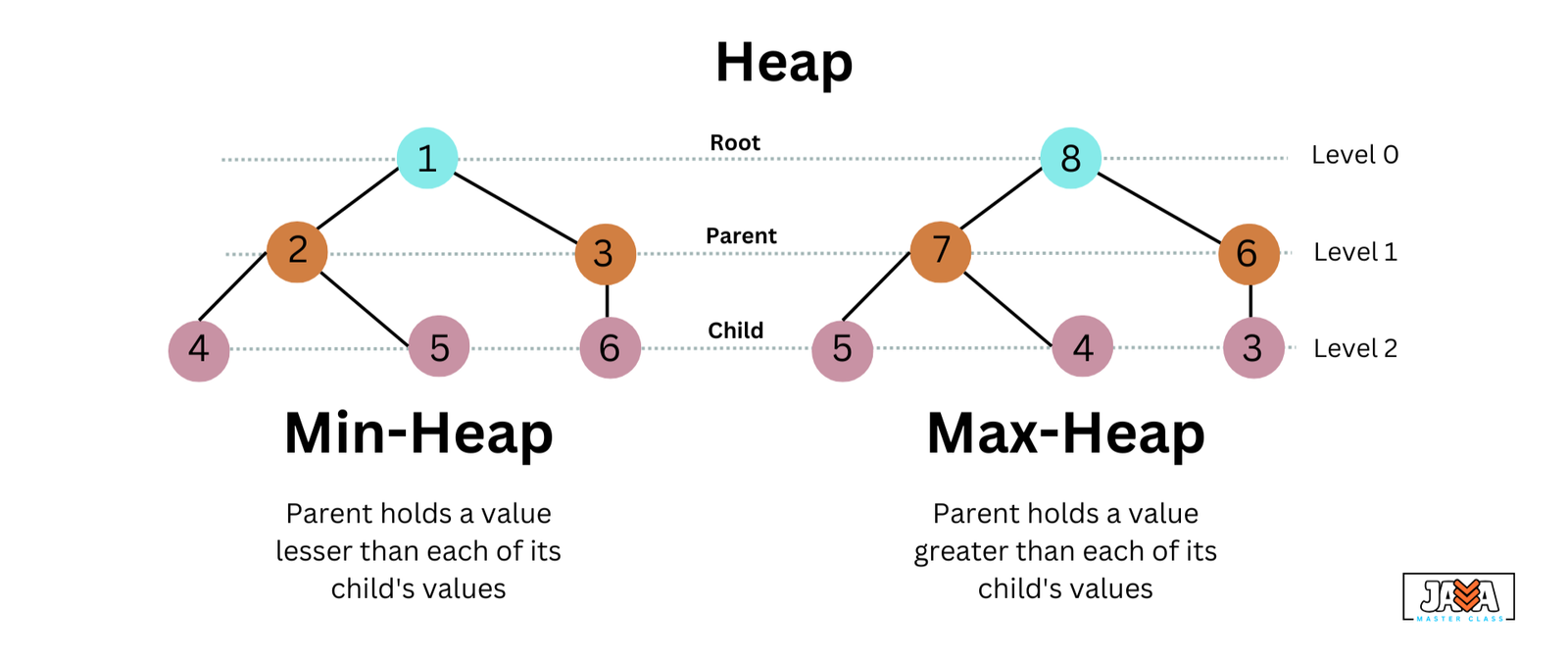A Heap is a special Tree-based data structure that satisfies the Heap Property.
Types of Heap
A heap is a complete binary tree where elements are arranged based on a specific order. There are different types of heaps:

- Min-Heap: The parent node is always smaller than its children. The smallest element is at the root.
- Max-Heap: The parent node is always larger than its children. The largest element is at the root.
- Binary Heap: A complete binary tree following the heap property.
- Fibonacci Heap: Advanced heap structure with better amortized time for decrease-key and merge operations, often used in complex graph algorithms.
Declaration & Initialization
In Java, PriorityQueue is the most common class to create heap structures, defaulting to a Min-Heap behavior.
|
1 2 3 4 5 |
// Min-Heap using PriorityQueue (default behavior) PriorityQueue<Integer> minHeap = new PriorityQueue<>(); // Max-Heap using PriorityQueue with reverse order comparator PriorityQueue<Integer> maxHeap = new PriorityQueue<>(Collections.reverseOrder()); |
Basic Operations
A heap supports three primary operations:
- Insertion (
addoroffer): Adds an element while maintaining the heap property. (O(log N)) - Deletion (
poll): Removes the root element and reorders the heap. (O(log N)) - Peek (
peek): Retrieves the root element without removing it. (O(1))
|
1 2 3 4 5 6 7 8 9 10 11 12 13 14 15 |
// Insertion (add elements) minHeap.add(15); minHeap.add(8); minHeap.add(25); // Deletion (poll removes the root, which is the smallest element in Min-Heap) int min = minHeap.poll(); // removes 8 (smallest) // Peek (to view the root without removing) int peekMin = minHeap.peek(); // returns 15 // Traversal (unordered, as heap does not guarantee sorted traversal) for (int val : minHeap) { System.out.println(val); } |
Implementation of Heap
Min-Heap Implementation
Java provides a built-in PriorityQueue class that internally uses a min-heap by default.
|
1 2 3 4 5 6 7 8 9 10 11 12 13 14 15 16 17 18 19 |
import java.util.PriorityQueue; public class HeapExample { public static void main(String[] args) { // Creating a Min-Heap PriorityQueue<Integer> minHeap = new PriorityQueue<>(); // Adding elements minHeap.add(20); minHeap.add(10); minHeap.add(30); minHeap.add(5); // Removing elements (smallest first) while (!minHeap.isEmpty()) { System.out.println(minHeap.poll()); // Prints elements in sorted order: 5, 10, 20, 30 } } } |
Max-Heap Implementation
|
1 2 3 4 5 6 7 8 9 10 11 12 13 14 15 16 17 18 19 20 |
import java.util.PriorityQueue; import java.util.Collections; public class MaxHeapExample { public static void main(String[] args) { // Creating a Max-Heap PriorityQueue<Integer> maxHeap = new PriorityQueue<>(Collections.reverseOrder()); // Adding elements maxHeap.add(20); maxHeap.add(10); maxHeap.add(30); maxHeap.add(5); // Removing elements (largest first) while (!maxHeap.isEmpty()) { System.out.println(maxHeap.poll()); // Prints elements in descending order: 30, 20, 10, 5 } } } |
Advantages & Disadvantages
| Advantages | Disadvantages |
|---|---|
| Fast insertion and deletion (O(log n)) | Poor performance for arbitrary search (O(n)) |
| Easy to implement using arrays | Doesn’t maintain sorted order during traversal |
| Ideal for priority-based tasks (Priority Queue) | Can require reheapify after updates |
Real World Examples
- Priority Queues: For scheduling tasks (OS process scheduling, CPU task management).
- Dijkstra’s Shortest Path Algorithm: Min-Heap is used to efficiently pick the next vertex with the smallest distance.
- Heap Sort Algorithm: Sorting technique that uses a Max-Heap to repeatedly remove the largest element.
- Event simulation systems: Where future events are scheduled based on priority or timestamps.
